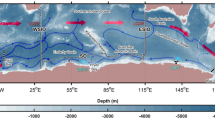Astract
The bottom layer in Osaka Bay was occupied in August from 1980 to 1995 by a water mass of relatively low temperature and rich in nutrients in comparison to previous and following decades. The relationship between Osaka Bay bottom temperature and Kuroshio axis location south of Kii Peninsula has been investigated using the dataset archived by Osaka Research Institute of Environment of Agriculture and Fisheries and axis-location data provided by Marine Information Research Center. The correlation between bottom temperature in the bay and Kuroshio-axis distance from Cape Shionomisaki indicates that the bottom temperature in the bay decreases when the Kuroshio axis is a long distance from the cape, and vice versa. To investigate why the temperature distribution depends on the axis location, composite temperature maps are depicted using summer temperature data from 1970 to 2005 archived in the Japan Oceanographic Data Center (JODC) after dividing all data into two groups with different axis locations. These temperature maps and temperature-salinity plots using the same JODC data suggest a scenario: cold water in the Kuroshio intermediate layer is first upwelled on the eastern side of the Kii Peninsula and thereafter moves westward as a coastal boundary current in the Kelvin wave sense of the Northern Hemisphere when the Kuroshio axis is located around 74-km distance from Cape Shionomisaki. This scenario is validated using internal Froude number maps depicted using the JODC-archived hydrographic data and geostrophic current fields. In addition, the reanalysis daily data provided by Japan Coastal Ocean Predictability Experiment are used for the validation.
Similar content being viewed by others
References
Fujiwara, T., S. Kobayashi, M. Kunii and N. Uno (2006): Nitrogen and phosphorus in Seto Inland Sea: Their origin, budget and variability. Bull. Coast. Oceanogr., 43(2), 129–136 (in Japanese).
Ishii, D. and T. Yanagi (2006): Pacific Ocean originated phosphorus and nitrogen in the Seto Inland Sea, Japan. Bull. Coast. Oceanogr., 43(2), 119–127 (in Japanese).
Kaneda, A., K. Norimatsu, K. Watanabe, Y. Koizumi and H. Takeoka (2002): Influence of onshore/offshore movements of the Kuroshio on the water temperature in the Bungo Channel, Japan. Bull. Coast. Oceanogr., 39(2), 181–188 (in Japanese).
Kawabe, M. (1985): Sea level variations at the Izu Islands and typical stable paths of the Kuroshio. J. Oceanogr. Soc. Japan, 41, 307–326.
Miyazawa, Y., T. Kagimoto, X. Guo and H. Sakuma (2008): The Kuroshio large meander formation in 2004 analyzed by an eddy-resolving ocean forecast system. J. Geophys. Res., 113, C10015.
Sekine, Y. and K. Uchiyama (2002): Outflow of the Intermediate Oyashio Water from Sagami Bay to the Shikoku Basin. J. Oceanogr., 58, 531–537.
Senjyu, T., N. Asano, M. Matsuyama and T. Ishimura (1998): Intrusion events of the Intermediate Oyashio Water into Sagami Bay, Japan. J. Oceanogr., 54, 29–44.
Takashi, T., T. Fujiwara, T. Sumitomo and W. Sakamoto (2006): Prediction of slope water intrusion into the Kii Channel in summer. J. Oceanogr., 62, 105–113.
Takeoka, H. and T. Yoshimura (1988): The Kyucho in Uwajima Bay. J. Oceanogr. Soc. Japan, 44, 6–16.
Takeuchi, J. (2001): Interannual and interdecadal variations in plankton biomass and intrusion of bottom cold water into Kii Channel. Umi to Sora, 72(2), 91–98 (in Japanese).
Talley, L. D. (1993): Distribution and formation of North Pacific Intermediate Water. J. Phys. Oceanogr., 23, 517–537.
Yang, S.-K., Y. Nagata, K. Taira and M. Kawabe (1993a): Southward intrusion of the Intermediate Oyashio Water along the east coast of the Boso Peninsula. I. Coastal salinity-minimum layer water off the Boso Peninsula. J. Oceanogr., 49, 89–114.
Yang, S.-K., Y. Nagata, K. Taira and M. Kawabe (1993b): Southward intrusion of the Intermediate Oyashio Water along the east coast of the Boso Peninsula. II. Intrusion events into Sagami Bay. J. Oceanogr., 49, 173–191.
Yasuda, I., K. Okuda and Y. Shimizu (1996): Distribution and modification of North Pacific Intermediate Water in the Kuroshio-Oyashio interfrontal zone. J. Phys. Oceanogr., 26, 448–465.
Author information
Authors and Affiliations
Corresponding author
Rights and permissions
About this article
Cite this article
Sugimatsu, K., Isobe, A. Intrusion of Kuroshio-Derived bottom cold water into Osaka Bay and its possible cause. J Oceanogr 66, 191–199 (2010). https://doi.org/10.1007/s10872-010-0017-9
Received:
Revised:
Accepted:
Published:
Issue Date:
DOI: https://doi.org/10.1007/s10872-010-0017-9




